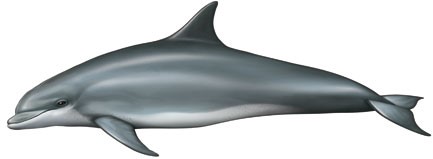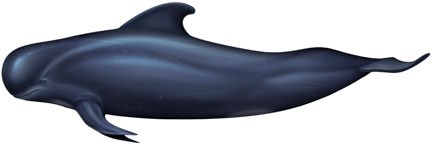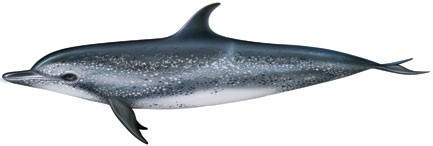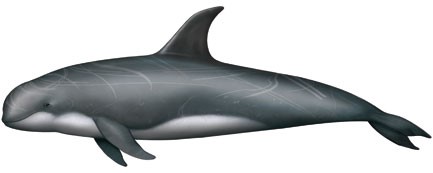Whales and Dolphins in Tenerife
Whales and Dolphins in Tenerife
Information about whales and dolphins
Source of wisdom
Up to 21 different species of whales and dolphins can be found in the waters of the island of Tenerife. From the gigantic blue whale to the fearsome killer whale, it is possible to spot any of them, although the most common are the Calderón Tropical and the Bottlenose Dolphin.
The crews of the White Tenerife boats will help you differentiate one species from another in the open sea, since at first glance it can be somewhat complicated for people unfamiliar with these mammals, especially if they are not close to the boat.
However, if you look at certain physical attributes, you can get pretty close to distinguishing the species sighted: size, head shape, dorsal fin, body and tail, body color, and behavior.
Whale and dolphin watching on the south coast of the island of Tenerife is an activity that can be practiced all year round. They cross the sea that stretches between the islands of Tenerife and La Gomera, a small strip that is the point where there are more whale sightings in Europe and one of the most important on the planet. The cetaceans have chosen it as their home due to the warmth (20º annual average) and depth of its waters (up to 2400 meters in some points) and for the delicacies they find in them, infinite colonies of squid, fish and organic material.
Residents: All year round in a fixed area

Bottlenose dolphin (Tursiops truncatus)
It is the best known species of dolphin and can be easily found just off the coast of Tenerife. Their average height is 2.7 meters for males and 2.5 for females, although the oldest ones exceed 3 meters. They live in groups of 10 to 30 specimens and have a dark gray color on the back that degrades towards the lower areas.

Short-finned Pilot Whale (Globicephala macrorhynchus)
Also known as “Pilot Whale” or “Short-finned pilot whale”, it belongs to the dolphin family. It is a cetacean with teeth (odontocete) and its name of whale is due to its size: it can exceed 5 meters in length and weigh between 1 and 2 tons. It is the easiest specimen to find on a sighting trip in Tenerife.
Sporadic: All year without frequency

Atlantic spotted dolphin (Stenella frontalis)
This species is characterized by the specks that cover most of its skin in adulthood. They form large groups and have a very active behavior. They can be seen more frequently from fall to the end of spring. Weight: 60-80 kg. Size: up to 2.3 meters.

Striped dolphin (Stenella coeruleoalba)
Thanks to its bluish coloration and the stripes (stripes) that go from the eyes to almost the tail, this dolphin is very easy to identify. He is sometimes elusive with boats, although he is a very fast swimmer who likes to jump out of the water. Weight: 100-130 kg. Size: 2.7 meters.

Pilot whale (Grampus griseus)
It is morphologically very similar to the tropical pilot whale, but it differs in the gray color of its skin (almost white in some adult specimens) and the contrast with the dorsal fin, which is still dark. Weight: 300-600 kg.

Rough-toothed dolphin (Steno bredanensis)
The stretch marks on its teeth and its elongated skull are the most representative characteristics of this species. It is a dolphin darker than the bottlenose and has lighter spots. They are distributed in groups of 6 to 10 specimens. Weight: up to 150 kg. Size: up to 2.7 meters.

Fin whale (Balaenoptera edeni)
It is similar in appearance to the fin whale, although the fin whale is smaller and more robust and has a unique feature in the Family, which are the three dorsal ridges instead of a central one. The length in males is 13.7 m and in females 14.5 m, with a maximum length of 15 m. The back is dark bluish gray to metallic gray, with lighter flanks and pale throat and belly.

Sperm whale (Physeter macrocephalus)
This species is the largest of the odontocetes, as it is equal to the whales in size. Its gigantic head, its dark striated skin and its small dorsal fin stand out. Apnea for more than an hour to search for food more than 2,000 meters deep. It is more common to see them in spring. Weight: 15-60 tons. Size: 11-18 meters.
Seasonal / migratory: At some time of the year

Common dolphin (Delphinus delphis)
The common dolphin is present in most of the seas of the planet. It is easily identifiable by the special yellowish coloration on the flanks. They can be seen more likely in winter. Weight: 80-130 kg. Size: up to 2.5 meters.

Fin whale (Balaenoptera borealis)
The fin whale reaches 17.1 m in males, 18.6 m in females and can weigh 25,000. It is similar to the fin whale, although larger, darker and slimmer, and with a single face. The head has similar proportions to that of the fin whale, showing 1/4 to 1/5 of its total length, but narrower when viewed from above and with a well defined crest. The general coloration is dark gray or brown (it can be close to black), sometimes similar to galvanized metal, except in the ventral area, which is whitish and of variable extension.

Fin whale (Balaenoptera physalus)
The most distinctive feature of the fin whale is its coloration. The dorsal and lateral body is black or dark gray-brown, gradually turning white towards the ventral area. However the color on the head is asymmetrical. The right side of the face is light gray and the jaw is white, like the rest of the coloration of the throat and belly. The left half of the face is darker, with the jaw and part of the throat dark gray. It presents a series of transverse discolorations on the back behind the head, the most apparent in the shape of an inverted V and more marked on the right side.

False killer whale (Pseudorca crassidens)
It has a slim body with a dorsal fin that can measure about 12 inches. High. A distinctive feature of this species are the curved and bulging characteristics (usually called the "elbow") midway along each of the fins. The false killer whale has a uniform color (dark gray to black). It grows up to 6 m long, can weigh 1,500 kg and live for about 60 years. It is a sociable animal, living in groups of 10 to 50 individuals.
Rarely
- Blainville's beaked whale (Mesoplodon densirostris)
- Common beaked whale (Ziphius cavirostris)
- Gervais beaked whale (Mesoplodon europaeus)
- Pygmy sperm whale (Kogia breviceps)
- Fraser's dolphin (Lagenodelphis hosei)
- Fin whale (Balaenoptera musculus)
- Yubarta (Megaptera novaeangliae)
- Minke whale (Balaenoptera acutorostrata)
- Orca (Orcinus orca)
Some curiosities about whales and dolphins
The pilot whale can submerge up to 1,000 meters for more than 20 minutes. In addition, its scientific name (Globicephala) refers to its balloon-shaped head.
The waters of the southwest of Tenerife are the largest bottlenose dolphin breeding area in all of Europe.
The common dolphin is one of the fastest cetaceans, capable of swimming at almost 45 km / h.
The striped dolphin can jump to a height of 7 meters, 3 times the length of its body.
The spotted dolphins form pods of hundreds of specimens. The youngest can be confused with the bottlenose dolphin.
The way to distinguish a shark from a cetacean is the tail: that of cetaceans is horizontal, while sharks have it vertically.
The pilot whale (also called pilot whale) or the killer whale (misnamed “killer whale” for feeding on other cetaceans) are odontocetes that measure more than 4 meters.
Members of a group of rough-toothed dolphins come out to breathe in sync.
Sperm whales can have up to 50 teeth, some of them over 1 kg. of weight.
A specimen of blue whale, the largest animal that has ever existed on Earth, reaches 33 meters long. In addition, they can eat 6 to 8 tons of food a day and their young need 100 liters of milk a day.

